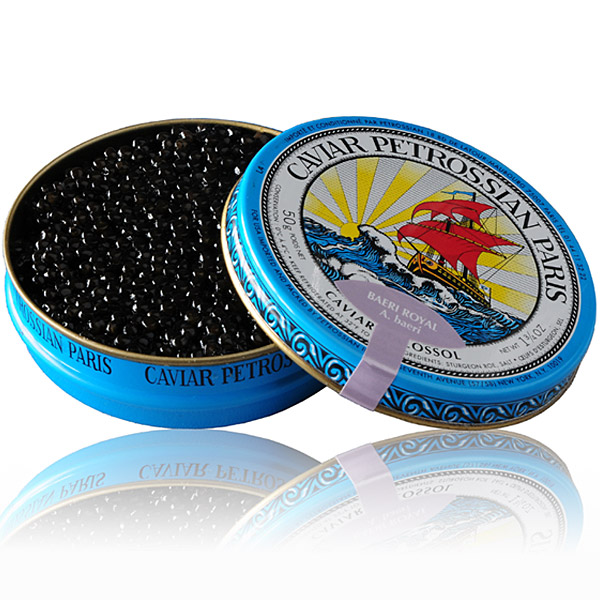My eyes always widened with excitement when there is a cause to celebrate with a fare of exceptional caviar. It was recently on a field trip to Petrossian, when I realized there is a world of knowledge that comes along with caviar. But you don’t need to become a caviar connoisseur to to understand the basic knowledge of etiquette, many different varieties and special utensils required to serve with caviar. Below is a guide to everything a wife should know before ordering caviar at your next lunch or serving it at your next dinner party . -Taryn Cox for THE WIFE
Strictly speaking, the correct and proper definition of caviar is limited to eggs harvested from different species of sturgeon, traditionally Beluga, Osetra and Sevruga sturgeon from the Caspian Sea in Russia and Iran. However, the rising popularity of other types of fish roe in modern cuisine has caused the definition of “caviar” to broaden. Nowadays, basically any fish egg is referred to as caviar.
A Brief History:
Types of Caviar:
Beluga Caviar: The best, rarest – and definitely the most expensive- of caviar’s is the Beluga Caviar, traditionally harvested in the Caspian Sea fisheries in Russia and Iran, from the white beluga sturgeon. Beluga roe is superb- large eggs, soft in texture, heavy and ripe, ranging from pale silver to black in color. By far the highest quality caviar you can get, with the most superior flavor. Soft, buttery taste, with a delicate and sweet flavor.
Sterlet: The small golden strerlet caviar which is rare and was once reserved for Russian, Iranian and Austrian royalty. Female Sterlet mature after five to seven years and produce a small-grain caviar. Sterlet caviar is light to dark gray in color and has a distinctively strong and intense flavor. It is most similar to Sevruga with regard to size and over all appearance offering an assertive styled caviar with a clean finish. Sterlet caviar makes for a perfect addition to caviar tastings or food pairings offering another worthy Caspian selection.
Osetra: The next-best-thing to Beluga Caviar, Osetra is of medium-size, and comes from the osetra sturgeon, harvested mainly in Russian and Iran. You’ll find caviar fans that will swear by this caviar, preferring it over beluga. To rest the case, osetra is a fantastic product all the way around, and in the world of gourmet caviar, it is definitely not a runner-up. It is intensely nutty, and has an oilier, silkier texture that just melts in your mouth. It is more recognizable due to its golden yellow/brownish color. Golden Ossetra or Golden Imperial caviar is highly sought-after by connoisseurs, and is very expensive. It is light to dark brown with golden highlights, Delectably fresh and fruity, Osetra has a firm, juicy grain with a distinctive nutty taste.
Sevruga: Here’s an option for those with a budget in mind: Sevruga caviar. You get the high quality and taste of a sturgeon roe, but from a far more common species of fish, therefore making it more available, and thus less expensive. The sevruga sturgeon is small, and reproduces faster that the other species, so this caviar is cheaper and easier to find. Taste-wise, it is strong, but the eggs are on the smallish side (slightly greenish or gray) and crunchier than the other sturgeon varieties. It is light to dark grey with brown highlights, The smaller beads of Sevruga allow for an intense, robust flavor of sea, green nuts, bitter orange, and cashew.
Salmon Roe: This is the cheaper alternative to caviar having been developed from the roe of whitefish and the North Atlantic salmon.
Accouterments to Serve with Caviar:
For serving accompaniments, always present caviar with blini’s (A small Russian pancake), toast points or unsalted crackers with crème fraiche. These are very subtle flavors made specifically to let caviar’s full flavor shine through.
Save the following garnishes for inferior grades of caviar:
- Lemon Wedges
- Finely Chopped Onion
- Capers
- Chopped Hard Boiled Egg
What to Drink with Caviar:
Champagne: Any excellent chilled brut or extra brut champagne will usually do. The savory saltiness of caviar finds another perfect counterpoint in the clean, crisp flavor of Champagne, preferably a dry, yeasty one with undertones of citrus flavor. And when serving these great epicurean pleasures, by all means invest in a set of fine glass flutes and a wine bucket to keep the bottle chilled.
Vodka: A venerable Russian tradition, the pairing of vodka and caviar is customary throughout the world of gastronomy. Like wine and cheese, they are the ideal complements to one another. Served ice cold, vodka has a subtle flavor that allows the distinctive taste of caviar to prevail.
Choose a high-quality traditional brand and make sure it is well chilled, at least four hours or as long as overnight. (Vodka can be stored indefinitely in the freezer; it will not freeze but does become syrupy.) Serve vodka straight, in chilled tumblers or vodka glasses, or over ice, if desired.
Wine: Chilled dry white wine as a substitute for Champagne. Good choices include a crisp white Burgundy, such as Chablis, Pouilly-Fuissé or an austere New World Chardonnay. Any rich, oaky wine would only mask the delicate flavor of caviar.
Storing Caviar:
Caviar is always packaged in small containers and meant to be consumed in one serving the same day. Unopened, its quality can be maintained for up to four weeks. After purchasing it should be kept in the coolest part of your refrigerator (28 – 32 degrees) and kept unopened and refrigerated until ready to serve. Don’t save leftovers as the caviar will change in taste and spoil quickly.
Serving Caviar:
You can estimate 1 oz. of caviar for every 2 people. Caviar should always be served chilled and NEVER at room temperature. If you’re keeping it out to serve, maintain chilled caviar by keeping it in the original jar or tin over a bed of crushed or shaved ice.
Utensils for Caviar:
Caviar should ALWAYS be served with a non metallic spoon, like mother of pearl, glass or plastic. Metal and stainless steel plates and or utensils change the taste of the caviar and make it taste bitter or metallic.
Eating Caviar:
It is traditional etiquette to eat caviar in small bites, and if you’re just learning to eat it, small bites will help you experience the flavor more completely without becoming overwhelmed by the flavor or texture. A good rule of thumb is: Help yourself to amounts as small as a teaspoon. So as not to break the eggs, caviar should be spooned carefully with mother of pearl spoons onto lightly toasted bread or directly in the mouth. -Petrossian, Wikipedia, William Sonoma, Caviar Russe, Gourmet Food Store









5 comments ↓
Yum!!! Now I’m craving caviar!
Never knew about the non metallic silverware rule, thanks for the tips.
Time for a trip to Petrossian!
Hello dear,
i need information Regarding Beluga caviar from Caspian sea, packaging size and prices.
Thanks,
Albert Nazarians
My brother recommended I might like this blog.
He was totally right. This posst actually made my
day. You can not believe simply how a lot time I had spent
for this information! Thank you!
Leave a Comment